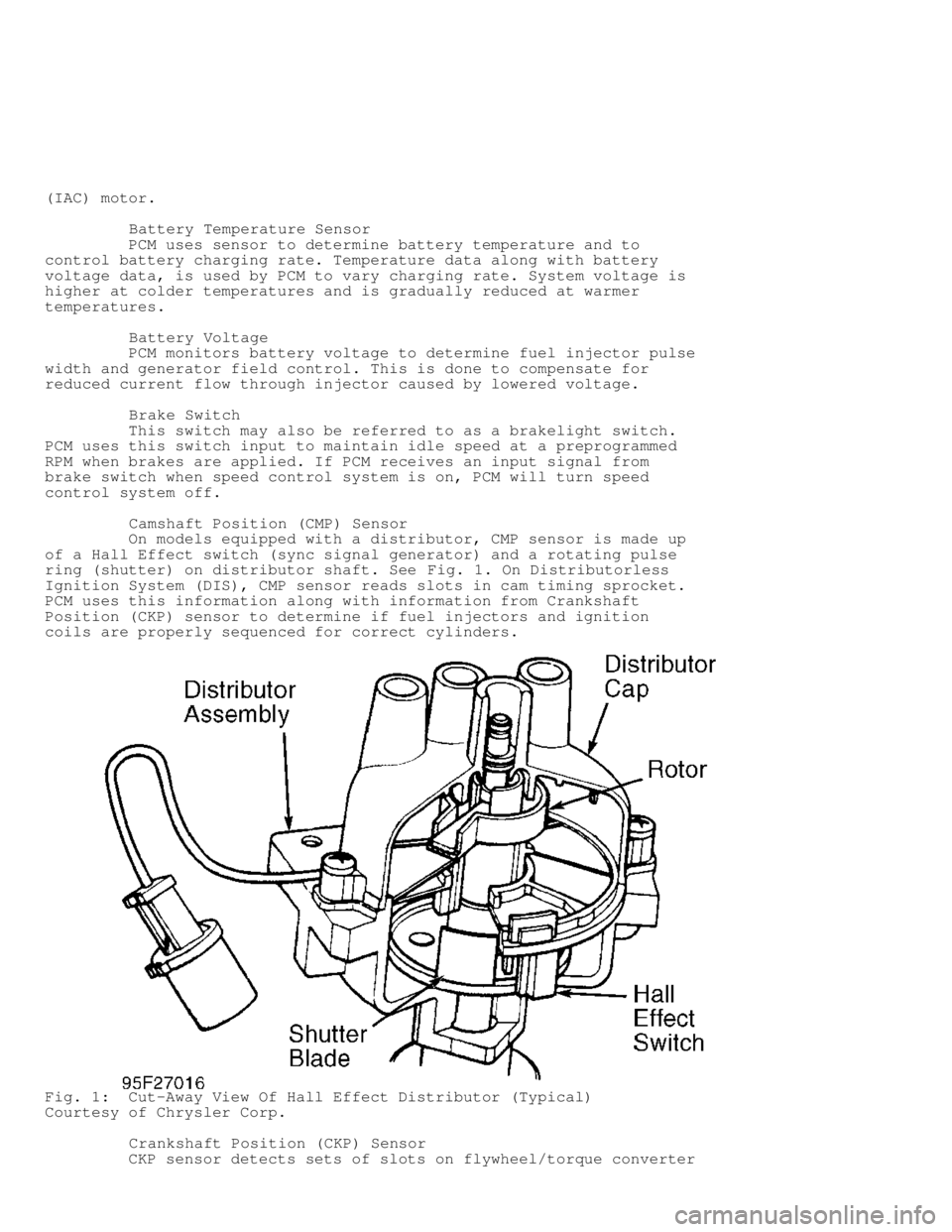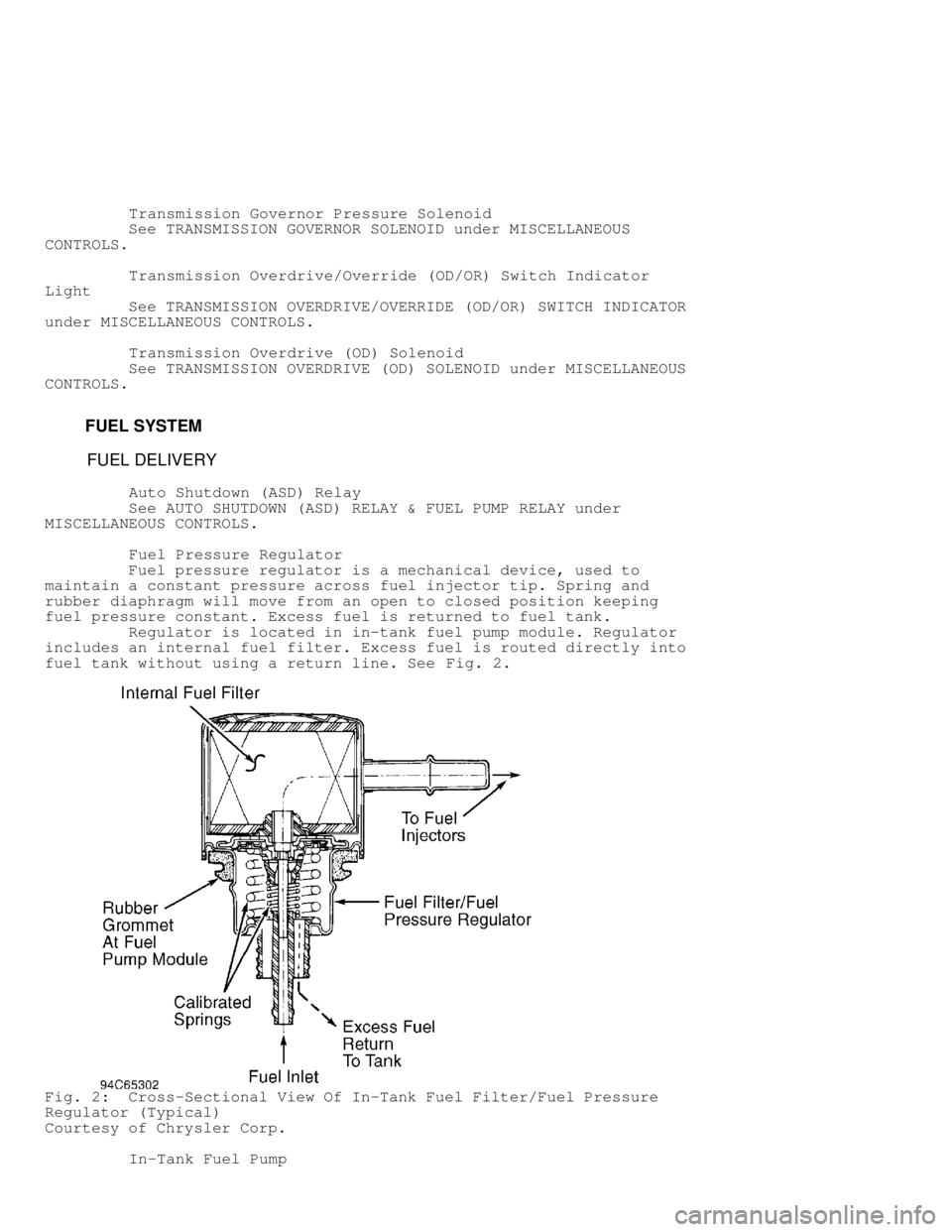1999 DODGE RAM light
[x] Cancel search: lightPage 1473 of 1691

Module (FPCM). Because of electronic control, pump timing is not
adjustable. See ON-VEHICLE ADJUSTMENTS - TRUCKS - DIESEL article.
FUEL FILTER/WATER SEPARATOR
Fuel filter/water separator is located on left side of engine
and contains fuel heater, Water-In-Fuel (WIF) sensor and drain valve.
See Fig. 2 . The WIF sensor delivers an input signal to Engine Control
Module (ECM) when water exists in fuel filter/water separator. ECM
will then turn on WATER-IN-FUEL warning light. WATER-IN-FUEL warning
light is located on instrument panel, just below tachometer. The
WATER-IN-FUEL warning light informs the operator to drain water from
fuel filter/water separator to prevent damage to fuel system
components. Water may be drained from fuel filter/water separator by
using drain valve on fuel filter/water separator.
FUEL HEATER
Fuel heater is used to prevent diesel fuel from waxing during
cold temperatures. Fuel heater is located in fuel filter/water
separator. See Fig. 2. Fuel flows from fuel tank to fuel transfer pump
and then to fuel filter/water separator. Fuel heater contains a fuel
heater temperature sensor that senses the fuel temperature. When
temperature is less than 37-53
�F (3-12�C), fuel heater temperature
sensor allows current to flow to the fuel heater to warm the fuel.
When temperature is more than 67-83
�F (19-28�C), fuel heater
temperature sensor turns off the current flow to the fuel heater.
Voltage to operate fuel heater is provided from ignition switch,
through fuel heater relay and to fuel heater. Fuel heater and fuel
heater relay are not controlled by Engine Control Module (ECM).
EMISSION SYSTEMS
INTAKE MANIFOLD AIR HEATER SYSTEM
Intake manifold air heater is used to warm intake air during
cold starting conditions. Heater system consists of 2 relays and 2
grid heaters installed on top of intake manifold. See Fig. 5.
Engine Control Module (ECM) energizes intake manifold air
heater relays to provide voltage to intake manifold air heater before
and after starting depending on input signals from intake manifold air
temperature sensor, engine speed sensor and vehicle speed. Intake
manifold air heater relays are not energized when intake manifold air
temperature is greater than 59
�F (15�C) or during engine cranking.
Intake manifold air heater relays are mounted on left inner wheelwell,
below left side battery. See Fig. 6.
Intake manifold air temperature sensor monitors intake
manifold air temperature and delivers an input signal to ECM for
controlling intake manifold air heater. Intake manifold air
temperature sensor is located in intake manifold. See Figs. 2 and 4.
SELF-DIAGNOSTIC SYSTEM
DATA LINK CONNECTOR
The Data Link Connector (DLC) is a 16-pin connector located
at lower edge of driver's side of instrument panel, just above the
accelerator pedal. The Engine Control Module (ECM) contains a self-
diagnostic system which stores a Diagnostic Trouble Code (FTC) if an
incorrect signal or no signal is received from certain sensors or
components. FTC may be retrieved from ECM for system diagnosis by
Page 1474 of 1691

using DLC and a scan tool. The DLC also provides a means to
communicate with various vehicle control modules, check system
operating conditions and to operate various system components.
MALFUNCTION INDICATOR LIGHT (MIL)
The MIL is located on the instrument panel, just below
tachometer and may also be referred to as the CHECK ENGINE light. MIL
comes on for a short period and then goes off as a bulb and wiring
circuit test each time ignition switch is turned to the ON position.
If Engine Control Module (ECM) receives an incorrect signal or
receives no signal from certain sensors or components, ECM will turn
on the MIL to warn the driver that a malfunction exists in the
electronic system.
MISCELLANEOUS CONTROLS
TRANSMISSION
Transmission Overdrive Solenoid (A/T Models)
Engine Control Module (ECM) operates transmission overdrive
solenoid for controlling transmission overdrive shifts. Transmission
overdrive solenoid is located on transmission valve body.
Transmission Torque Converter Clutch Solenoid (A/T Models)
Engine Control Module (ECM) operates transmission torque
converter clutch solenoid for torque converter lock-up. ECM uses
various input signals such as transmission temperature, output shaft
speed, central module timer, engine speed, APPS and brake switch
position to determine operation of transmission torque converter
clutch solenoid. Torque converter clutch solenoid is located on
transmission valve body.
Page 1476 of 1691

(IAC) motor.
Battery Temperature Sensor
PCM uses sensor to determine battery temperature and to
control battery charging rate. Temperature data along with battery
voltage data, is used by PCM to vary charging rate. System voltage is
higher at colder temperatures and is gradually reduced at warmer
temperatures.
Battery Voltage
PCM monitors battery voltage to determine fuel injector pulse
width and generator field control. This is done to compensate for
reduced current flow through injector caused by lowered voltage.
Brake Switch
This switch may also be referred to as a brakelight switch.
PCM uses this switch input to maintain idle speed at a preprogrammed
RPM when brakes are applied. If PCM receives an input signal from
brake switch when speed control system is on, PCM will turn speed
control system off.
Camshaft Position (CMP) Sensor
On models equipped with a distributor, CMP sensor is made up
of a Hall Effect switch (sync signal generator) and a rotating pulse
ring (shutter) on distributor shaft. See Fig. 1. On Distributorless
Ignition System (DIS), CMP sensor reads slots in cam timing sprocket.
PCM uses this information along with information from Crankshaft
Position (CKP) sensor to determine if fuel injectors and ignition
coils are properly sequenced for correct cylinders.
Fig. 1: Cut-Away View Of Hall Effect Distributor (Typical)
Courtesy of Chrysler Corp.
Crankshaft Position (CKP) Sensor
CKP sensor detects sets of slots on flywheel/torque converter
Page 1479 of 1691

diagram in appropriate WIRING DIAGRAMS article. For theory
and operation on each output component, refer to indicated
system.
A/C Clutch Relay
See A/C CLUTCH RELAY under MISCELLANEOUS CONTROLS.
Auto Shutdown (ASD) Relay
See AUTO SHUTDOWN (ASD) RELAY & FUEL PUMP RELAY under
MISCELLANEOUS CONTROLS.
Distributorless Ignition System (DIS)
See DISTRIBUTORLESS IGNITION SYSTEM (DIS) under IGNITION
SYSTEM.
Evaporative Canister Purge Control Solenoid (EVAP-CPCS)
See EVAPORATIVE (EVAP) EMISSIONS SYSTEM under EMISSION
SYSTEMS.
Fuel Injectors
See FUEL CONTROL under FUEL SYSTEM.
Fuel Pump Relay
See AUTO SHUTDOWN (ASD) RELAY & FUEL PUMP RELAY under
MISCELLANEOUS CONTROLS.
Generator
See GENERATOR under MISCELLANEOUS CONTROLS.
Idle Air Control (IAC) Motor
See IDLE SPEED under FUEL SYSTEM.
Ignition Coil
See IGNITION SYSTEM.
In-Tank Fuel Pump
See FUEL DELIVERY under FUEL SYSTEM.
Limp-In Mode
See LIMP-IN MODE under MISCELLANEOUS CONTROLS.
Malfunction Indicator Light (MIL)
See MALFUNCTION INDICATOR LIGHT under SELF-DIAGNOSTIC SYSTEM.
Radiator Fan Relay
See RADIATOR FAN RELAY under MISCELLANEOUS CONTROLS.
Serial Communications Interface (SCI) Transmit
See SERIAL COMMUNICATIONS INTERFACE (SCI) under SELF-
DIAGNOSTIC SYSTEM.
Shift Indicator Light
See SHIFT INDICATOR LIGHT under MISCELLANEOUS CONTROLS.
Speed Control Servo
See SPEED CONTROL SERVO under MISCELLANEOUS CONTROLS.
Tachometer
See TACHOMETER under MISCELLANEOUS CONTROLS.
Torque Converter Clutch (TCC) Solenoid
See TORQUE CONVERTER CLUTCH (TCC) SOLENOID under
MISCELLANEOUS CONTROLS.
Page 1480 of 1691

Transmission Governor Pressure Solenoid
See TRANSMISSION GOVERNOR SOLENOID under MISCELLANEOUS
CONTROLS.
Transmission Overdrive/Override (OD/OR) Switch Indicator
Light
See TRANSMISSION OVERDRIVE/OVERRIDE (OD/OR) SWITCH INDICATOR
under MISCELLANEOUS CONTROLS.
Transmission Overdrive (OD) Solenoid
See TRANSMISSION OVERDRIVE (OD) SOLENOID under MISCELLANEOUS
CONTROLS.
FUEL SYSTEM
FUEL DELIVERY
Auto Shutdown (ASD) Relay
See AUTO SHUTDOWN (ASD) RELAY & FUEL PUMP RELAY under
MISCELLANEOUS CONTROLS.
Fuel Pressure Regulator
Fuel pressure regulator is a mechanical device, used to
maintain a constant pressure across fuel injector tip. Spring and
rubber diaphragm will move from an open to closed position keeping
fuel pressure constant. Excess fuel is returned to fuel tank.
Regulator is located in in-tank fuel pump module. Regulator
includes an internal fuel filter. Excess fuel is routed directly into
fuel tank without using a return line. See Fig. 2.
Fig. 2: Cross-Sectional View Of In-Tank Fuel Filter/Fuel Pressure
Regulator (Typical)
Courtesy of Chrysler Corp.
In-Tank Fuel Pump
Page 1485 of 1691

Crankcase Ventilation (PCV) system, but does not use a vacuum
controlled valve. See POSITIVE CRANKCASE VENTILATION (PCV).
EVAPORATIVE (EVAP) EMISSIONS SYSTEM
This system stores fuel vapors from fuel tank, preventing
vapors from reaching the atmosphere. As fuel evaporates inside fuel
tank, vapors are routed through vent hoses to charcoal canister where
they are stored until engine is started.
Evaporative Canister Purge Control Solenoid (EVAP-CPCS)
Charcoal canister purging is controlled by PCM through an
EVAP-CPCS. During engine warm-up and for a short period after hot
restarts, PCM energizes EVAP-CPCS, interrupting engine vacuum signal
to charcoal canister.
After engine reaches a predetermined operating temperature
and PCM internal timer has expired, PCM will de-energize EVAP-CPCS,
allowing engine vacuum to purge charcoal canister. EVAP-CPCS will also
be de-energized during certain idle conditions so PCM can update fuel
delivery calibration.
POSITIVE CRANKCASE VENTILATION (PCV)
PCV system uses a vacuum operated valve. A closed engine
crankcase breather/filter, with a hose connecting it to air filter
housing, provides source of air for system. Crankcase blow-by gases
are removed from crankcase through PCV valve with manifold vacuum.
These gases are introduced into incoming air/fuel mixture and become
part of the calibrated mixture.
A non-vacuum operated Crankcase Ventilation (CCV) system is
used on some engines, see CRANKCASE VENTILATION (CCV) SYSTEM.
SELF-DIAGNOSTIC SYSTEM
The PCM monitors several different circuits of engine control
system. If a problem is sensed with a monitored circuit, PCM will
store a Diagnostic Trouble Code (FTC) to aid technician in diagnosis
of system. The Malfunction Indicator Light (MIL), or a scan tool can
be used to read DTCs. For additional information, see SELF-DIAGNOSTICS
- JEEP, TRUCKS & RWD VANS article.
MALFUNCTION INDICATOR LIGHT
Malfunction Indicator Light (MIL) comes on and remains on for\
3 seconds as a bulb test each time ignition switch is turned to ON
position. If PCM receives an incorrect signal or receives no signal
from battery voltage input, charging system, ECT sensor, MAP sensor or
TP sensor, MIL will come on. MIL will also come on if certain
emission-related faults exist. This warns driver that PCM is in limp-
in mode and immediate repairs are necessary. See LIMP-IN MODE under
MISCELLANEOUS CONTROLS. MIL can also be used to display Diagnostic
Trouble Codes (DTCs). For additional information, see SELF-DIAGNOSTICS\
- JEEP, TRUCKS & RWD VANS article.
SERIAL COMMUNICATIONS INTERFACE (SCI)
SCI circuit is used by PCM to send data to and receive data
and sensor activation signals from scan tool. Scan tool uses signals
sent on SCI to display fault messages or Diagnostic Trouble Codes
(DTCs), sensor voltages and device states (On/Off). Scan tool uses S\
CI
to send solenoid and switch activation commands to PCM so that devices
and circuits can be tested. SCI is also used to write SRI mileage to
Page 1486 of 1691

PCM.
MISCELLANEOUS CONTROLS
NOTE: Although not strictly considered part of engine performance
system, some controlled devices can adversely affect
driveability if they malfunction.
A/C CLUTCH RELAY
A/C clutch relay is controlled by PCM. When A/C or Defrost
mode is selected and PCM receives A/C request signal from evaporator
switch, PCM will cycle clutch on and off through A/C clutch relay.
When this relay is energized during engine operation, PCM will
determine correct engine idle speed through IAC motor.
When PCM senses low idle speed or wide open throttle through
TP sensor, PCM will de-energize A/C clutch relay, preventing A/C
operation.
AUTO SHUTDOWN (ASD) RELAY & FUEL PUMP RELAY
ASD relay and electric fuel pump relay are energized when
ignition is on. These relays are controlled through PCM by switching a
common ground circuit on and off. Following components are controlled
by ASD and fuel pump relays:
* Electric Fuel Pump
* Fuel Injectors
* Generator Field Winding
* Ignition Coil(s)
* HO2S Heating Element
When ignition switch is turned to RUN position, PCM energizes
ASD relay and electric fuel pump relay which powers these components.
If PCM does not receive a CMP and CKP sensor signal within one second
of engine cranking (start-up), PCM will turn ground circuit off and
de-energize ASD relay.
GENERATOR
Powertrain Control Module (PCM) regulates charging system
voltage.
LIMP-IN MODE
Limp-in mode is the attempt by PCM to compensate for failure
of certain components by substituting information from other sources
so that vehicle can still be operated. If PCM senses incorrect data or
no data at all from MAP sensor, TP sensor, ECT sensor or battery
voltage, system is placed into limp-in mode and Malfunction Indicator
Light (MIL) on instrument panel comes on.
If faulty sensor comes back on line, PCM will resume closed
loop operation. On some vehicles, MIL will remain on until ignition is
shut off and vehicle is restarted. To prevent damage to catalytic
converter, vehicle should NOT be driven for extended periods in limp-
in mode.
RADIATOR FAN RELAY
Electric cooling fan is used only on Dakota. Using
information supplied by A/C signal (if equipped), ECT sensor, and VSS,\
Page 1487 of 1691

PCM controls operation of electric cooling fan. PCM operates fan
through radiator fan relay by grounding or ungrounding relay control
circuit. PCM regulates engine idle speed through IAC motor when fan is
on.
SHIFT INDICATOR LIGHT
PCM provides ground for shift indicator light on models
equipped with manual transmission. Based on engine speed, throttle
position, and vehicle speed, PCM turns shift indicator light on to
advise driver to shift to a higher gear for optimum fuel economy.
SPEED CONTROL SERVO
System is electrically actuated and vacuum operated. Controls
are located on steering wheel. Controls consist of 3 buttons: OFF/ON,
RESUME/ACCEL and SET/DECEL. Speed control servo is controlled by PCM.
System will operate at 35-85 MPH.
TACHOMETER
PCM provides signal to drive tachometer.
TORQUE CONVERTER CLUTCH (TCC) SOLENOID
PCM controls torque converter lock-up through TCC solenoid.
PCM controls lock-up according to various operating conditions.
TRANSMISSION GOVERNOR SOLENOID
PCM controls solenoid to regulate line pressure for shift
control.
TRANSMISSION OVERDRIVE/OVERRIDE (OD/OR) SWITCH INDICATOR
LIGHT
PCM controls indicator light on OD/OR switch on models
equipped with overdrive automatic transmission.
TRANSMISSION OVERDRIVE (OD) SOLENOID
On models equipped with OD transmission, PCM controls 3-4 OD
upshift and downshift through OD solenoid. PCM determines optimum OD
shift scheduling for all operating conditions.